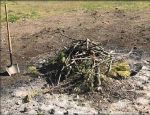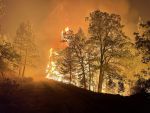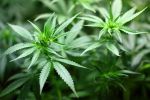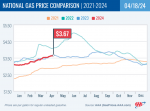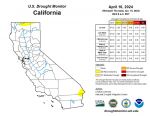June 20, 2018 - By Christine Souza - At indoor and outdoor laboratories across the country, researchers use the latest science to find solutions to stresses that plague honeybees. The outcome of their work matters greatly not only to beekeepers, but to farmers whose crops depend on bees for pollination. (Left) University of California, Davis, doctoral student Clara Stuligross checks a blue orchard bee nest as part of a research project looking at various impacts on bee health. Blue orchard bees, a native species, can be used in combination with managed honeybees to enhance pollination in crops such as almonds. Photo/Christine Souza
(Left) University of California, Davis, doctoral student Clara Stuligross checks a blue orchard bee nest as part of a research project looking at various impacts on bee health. Blue orchard bees, a native species, can be used in combination with managed honeybees to enhance pollination in crops such as almonds. Photo/Christine Souza
"Our industry is still not healthy, as winter and annual colony losses continue to be high," said beekeeper Gene Brandi of Los Banos, past-president of the American Beekeeping Federation.
Brandi said survey results released last month by the Bee Informed Partnership showed a 40 percent loss of managed colonies during the most recent 12-month survey period, and said that figure appeared low to him.
"I am aware of too many large commercial beekeepers who incurred winter losses greater than 50 percent," Brandi said.
Beekeeper Mike Tolmachoff of Madera, president of the California State Beekeepers Association, identified the bee parasite Varroa mite as "the single greatest threat" to maintaining bee health.
"I am accustomed to losing 30 to 40 percent of my managed colonies annually and dealing with the financial burden that accompanies these losses," Tolmachoff said. "It is vital that researchers continue their efforts in finding solutions."
Millions of dollars are invested in research at universities and by government agencies and other organizations, to benefit western or European honeybees, which beekeepers use to pollinate many California crops, with almonds the largest.
Project Apis.m—a group established by growers and beekeepers that has invested more than $6 million in honeybee research since 2006—said the Varroa protector mite, if left unchecked, will continue to kill bee colonies.
Danielle Downey, the organization's executive director, said the U.S. Department of Agriculture Honey Bee Lab in Baton Rouge, La., is developing improved honeybee stocks resistant to Varroa.
"This is one of the projects that we are most hopeful about," Downey said. "To produce this bee that can resist the Varroa mite damage could be a real game-changer for pollination sustainability. It's not enough to keep bees alive; we have to keep businesses profitable to continue the hard work of managing commercial pollination."
The breeding and genetics work involves the discovery of the "Varroa Sensitive Hygiene" trait. Researchers found that bees bred with the trait could detect Varroa mites inside a capped bee cell, and could open the cell and remove the contents. The behavior successfully interrupts and suppresses Varroa mite population growth, Downey said.
"For it to impact agricultural business and pollination, you must produce hundreds of thousands of these for the beekeepers to try and adopt," she said, adding beekeepers in North Dakota are managing bees with the Varroa-resistant trait as part of a field trial.
"This (research) wouldn't just reduce the mortality, it would reduce the inputs, and give us some breathing room while making the system more sustainable," Downey said.
USDA Agricultural Research Service spokeswoman Kim Kaplan agreed, "Varroa mites are probably the largest single problem contributing to colony damage and losses."
To help beekeepers and for use in research, ARS scientists have developed VarroaPop, software that predicts Varroa mite population growth and honeybee colony survival based on factors such as queen strength, foraging success, weather, colony resources and population structure.
"VarroaPop has contributed important new information about mite migration from colony to colony that may change fall treatment strategies for Varroa mites," Kaplan said. "VarroaPop suggests that movement of mites between colonies in the fall has been rendering treatment decisions traditionally based on mite counts unreliably effective."
Other research, from the University of Maryland, revealed Varroa mites are not sucking the blood of honeybees, but rather going after the fat bodies, or the stored energy, in the bees.
Honeybee parasites Nosema ceranae and Nosema apis can weaken individual bees and entire colonies, making them more susceptible to other pests and diseases. To battle these pests, ARS scientists in Beltsville, Md., are using a new approach—RNAi, or gene silencing, testing natural plant compounds with the potential to reduce Nosema and/or increase bee defenses, Kaplan said.
Other Nosema research by the University of California, Davis, in collaboration with Pennsylvania State University, is examining the genomics of honeybee pathogen interactions.
For honeybees to be more resilient to pests and disease, researchers say increasing forage diversity is especially important.
"For honeybees, what is most important is more substantial (forage) plantings are more heavily used," UC Davis Department of Entomology and Nematology Professor Neal Williams said. "Work shows that wildflowers don't compete with the orchard for the attention of honeybees as pollinators."
In recent years, researchers have developed seed mixes for plants that bloom at different times of the year. Seeds have been distributed to farmers and others for use as cover crops and wildflower strips.
UC Davis doctoral student Clara Stuligross is studying the effects of crop-protection materials and limited forage on the blue orchard bee, a native, solitary bee that complements honeybee pollination in orchards.
"The bees collect pollen and nectar from the flowers and put it in the nest, making a sort of lunch box for their offspring," Stuligross said. "I test the food that they are feeding to their offspring."
Future honeybee research may include development of a winter cover crop mix that benefits soil health and provides nutrition for bees, and a study of the effects of transportation of honeybees to California for almond bloom.
"There have been a number of good research projects that show promise, but we still need a great deal more successful, effective research that will result in new strategies to reduce these losses before the bee industry can turn the corner," Brandi said.
(Christine Souza is an assistant editor of Ag Alert. She may be contacted at csouza@cfbf.com.)
Reprinted with permission: California Farm Bureau Federation














